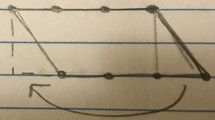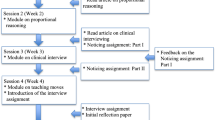Abstract
Several studies have documented prospective teachers’ (PSTs) difficulties in offering instructional explanations. However, less is known about PSTs’ learning to provide explanations. To address this gap, we trace changes in the explanations offered by a purposeful sample of PSTs before and after a mathematics content/methods course sequence. Consistent with prior research, our study reveals the limitations in PSTs’ explanations at their entrance to the course sequence. It also documents PSTs’ progress in providing explanations, thus providing existence proof that this practice is learnable. Using evidence from multiple sources, we also propose a component entailed in this learning—learning how to unpack one’s thinking through the use of representations as explanatory tools—and four factors associated with it, including PSTs’ subject-matter knowledge, active and deliberate reflection on practice, productive images for engaging in this work, and productive dispositions about engaging in this practice. We discuss the implications of our findings for teacher education and offer directions for future research.




Similar content being viewed by others
Notes
Although taught by a single instructor, these courses were the result of a collaborative effort of mathematics educators, mathematicians, practicing teachers, researchers, and graduate students, who, over the past 15 years, have worked together to design, teach, reflect on, and refine the courses (see more in Ball et al. 2009).
The letters denote whether the excerpt comes from a pre-coursework (PE), post-coursework (PO), or a post-program (PP) interview; the numbers represent the transcript lines from which the excerpt was drawn.
We use the term as defined in Ball and Bass (2003, p. 11): in contrast to mathematicians, who often present the content in compressed formats, teachers need to decompress the content to make it accessible to learners.
The letters denote whether the excerpt comes from notebook class-notes and reflections (NC), notebook homework (NH), comments on reflection cards (RC), the survey administered at the beginning of the content course (SC), or the survey administered at the beginning of the methods course (SM).
The remaining 12 PSTs for whom we had complete data displayed analogous learning paths: five PSTs started in places anywhere between Suzanne’s and Nathan’s pre-coursework performance and, by the end of coursework, provided explanations that resembled those of Nathan’s and Suzanne’s; four PSTs started in a similar place as Vonda and Suzanne and improved in providing explanations, although, not as dramatically as Suzanne; like Nathan, a PST learned to unpack his mathematically valid, yet condense, explanations; a PST displayed a remarkable learning growth tantamount to Suzanne; and another PST exited coursework with limitations in her capacity to provide explanations similar to those documented in Vonda’s case.
References
Ball, D. L. (1988). Knowledge and reasoning in mathematical pedagogy: Examining what prospective teachers bring to teacher education. Unpublished doctoral dissertation, Michigan State University, East Lansing.
Ball, D. L., & Bass, H. (2003). Toward a practice-based theory of mathematical knowledge for teaching. In B. Davis & E. Simmt (Eds.), Proceedings of the 2002 annual meeting of the Canadian mathematics education study group (pp. 3–14). Edmonton, AB: CMESC/GCEDM.
Ball, D. L., Sleep, L., Boerst, T. A., & Bass, H. (2009). Combining the development of practice and the practice of development in teacher education. The Elementary School Journal, 109(5), 458–474.
Borko, H., Eisenhart, M., Brown, C. A., Underhill, R. G., Jones, D., & Agard, P. (1992). Learning to teach hard mathematics: Do novice teachers and their instructors give up too easily? Journal for Research in Mathematics Education, 23, 194–222.
Bransford, J. D., Brown, A. L., & Cocking, R. R. (Eds.). (2000). How people learn: Brain, mind, experience, and school. Washington, CD: National Academy Press.
Charalambous, C. Y. (2008). Prospective teachers’ mathematical knowledge for teaching and their performance in selected teaching practices: Exploring a complex relationship. Unpublished doctoral dissertation, University of Michigan, Ann Arbor.
Charalambous, C. Y. (2010). Mathematical knowledge for teaching and task unfolding: An exploratory study. The Elementary School Journal, 110(3), 247–278.
Dewey, J. (1906). The child and the curriculum. Chicago: The University of Chicago.
Duffy, G. G., Roehler, L. R., Meloth, M. S., & Vavrus, L. G. (1986). Conceptualizing instructional explanation. Teaching and Teacher Education, 2, 197–214.
Grossman, P., Hammerness, K., & McDonald, M. (2009). Redefining teaching, re-imagining teacher education. Teachers and Teaching: Theory and Practice, 15, 273–289.
Grossman, P., & McDonald, M. (2008). Back to the future: Directions for research in teaching and teacher education. American Educational Research Journal, 45, 184–205.
Inoue, N. (2009). Rehearsing to teach: Content-specific deconstruction of instructional explanations in pre-service teacher training. Journal of Education for Teaching, 35(1), 47–60.
Izsák, A., Tillema, E., & Tunç-Pekkan, Z. (2008). Teaching and learning fraction addition on number line. Journal for Research in Mathematics Education, 39, 33–62.
Kinach, B. M. (2002). Understanding and learning-to-explain by representing mathematics: Epistemological dilemmas facing teacher educators in the secondary mathematics “methods” course. Journal of Mathematics Teacher Education, 5, 153–186.
Lampert, M. (2001). Teaching problems and the problems of teaching. New Haven, CT: Yale University Press.
Lampert, M. (2010). Learning teaching in, from, and for practice: What do we mean? Journal of Teacher Education, 60(1–2), 21–34.
Larreamendy-Joerns, J., & Muñoz, T. (2010). Learning, identity, and instructional explanations. In M. K. Stein & L. Kucan (Eds.), Instructional explanations in the disciplines (pp. 23–40). New York: Springer.
Leinhardt, G. (1987). Development of an expert explanation: An analysis of a sequence of subtraction lessons. Cognition and Instruction, 4, 225–282.
Leinhardt, G. (1989). Math lessons: A contrast of novice and expert competence. Journal for Research in Mathematics Education, 20, 52–75.
Leinhardt, G. (2001). Instructional explanations: A commonplace for teaching and location for contrast. In V. Richardson (Ed.), Handbook for research on teaching (4th ed., pp. 333–357). Washington, DC: American Educational Research Association.
Leinhardt, G. (2010). Introduction: Explaining instructional explanations. In M. K. Stein & L. Kucan (Eds.), Instructional explanations in the disciplines (pp. 1–5). NY: Springer.
Leinhardt, G., Putnam, R. T., Stein, M. K., & Baxter, J. (1991). Where subject knowledge matters. In J. Brophy (Ed.), Advances in research on teaching (Vol. 2, pp. 87–113). London: JAI Press Inc.
Leinhardt, G., & Steele, M. D. (2005). Seeing the complexity of standing to the side: Instructional dialogues. Cognition and Instruction, 23, 87–163.
Lloyd, G. M., & Wilson, M. R. (1998). Supporting innovation: The impact of a teacher’s conceptions of functions on his implementation of a reform curriculum. Journal for Research in Mathematics Education, 29, 248–274.
Lo, J., Grant, T., & Flowers, J. (2004). Developing mathematics justification: The case of prospective elementary school teachers. In D. McDougall & J. Ross (Eds.), Proceedings of the twenty-sixth annual meeting of the north American chapter of the international group for the psychology of mathematics education (Vol. 3, pp. 1159–1166). Toronto: University of Toronto.
Lubinksi, C. A., Thomason, R., & Fox, T. (1998). Learning to make sense of division of fractions: One K-8 preservice teacher’s perspective. School Science and Mathematics, 98, 247–253.
Martin, J. R. (1970). Explaining, understanding, and teaching. New York: McGraw-Hill.
Patton, M. Q. (2002). Qualitative research and evaluation methods (3rd ed.). Thousand Oaks, CA: Sage Publications.
Schoenfeld, A. H. (2010). How and why do teachers explain things the way they do? In M. K. Stein & L. Kucan (Eds.), Instructional explanations in the disciplines (pp. 83–106). New York: Springer.
Schwab, J. J. (1978). Education and the structure of the disciplines. In I. Westbury & N. J. Wilfolk (Eds.), Science, curriculum, and liberal education: Selected essays (pp. 229–272). Chicago: The University of Chicago Press.
Shadish, W. R., Cook, T. D., & Campbell, D. T. (2002). Experimental and quasi-experimental designs for generalized causal inference. Boston, MA: Houghton-Mifflin.
Simon, M. A. (1993). Prospective elementary teachers’ knowledge of division. Journal for Research in Mathematics Education, 31, 5–25.
Stecher, B., Vi-Nhuan, L., Hamilton, L., Ryan, G., Robyn, A., & Lockwood, J. R. (2006). Using structured classroom vignettes to measure instructional practices in mathematics. Educational Evaluation and Policy Analysis, 28, 101–130.
Stein, M. K., Baxter, J. A., & Leinhardt, G. (1990). Subject-matter knowledge and elementary instruction: A case from functions and graphing. American Educational Research Journal, 27, 639–663.
Strauss, A., & Corbin, J. (1998). Basics of qualitative research: Techniques and procedures for developing grounded theory (2nd ed.). Thousand Oaks, CA: Sage.
Thanheiser, E. (2009). Preservice elementary school teachers’ conceptions of multidigit whole numbers. Journal for Research in Mathematics Education, 40, 252–281.
Thompson, P. W., & Thompson, A. G. (1994). Talking about rates conceptually, part I: A teacher’s struggle. Journal for Research in Mathematics Education, 25, 279–303.
Thompson, A. G., & Thompson, P. W. (1996). Talking about rates conceptually, part II: Mathematical knowledge for teaching. Journal for Research in Mathematics Education, 27, 2–24.
Weiss, I. R., & Parsley, J. D. (2004). What is high-quality instruction? Educational Leadership, 65(1), 24–28.
Yin, R. K. (2003). Case study research: Design and methods (3rd ed.). Thousand Oaks, CA: Sage.
Author information
Authors and Affiliations
Corresponding author
Rights and permissions
About this article
Cite this article
Charalambous, C.Y., Hill, H.C. & Ball, D.L. Prospective teachers’ learning to provide instructional explanations: how does it look and what might it take?. J Math Teacher Educ 14, 441–463 (2011). https://doi.org/10.1007/s10857-011-9182-z
Published:
Issue Date:
DOI: https://doi.org/10.1007/s10857-011-9182-z




